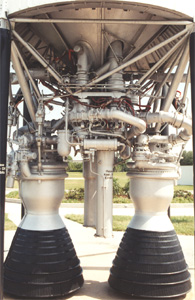
| Gemini Titan II |
This is the Titan II GLV (Gemini Launch Vehicle), also referred to as a Gemini Titan II. It is a modified version of the Titan II missile. This particular rocket stands in the Rocket Garden at the Kennedy Space Center.
The Titan II is a modified version of the Martin Marietta (now Lockheed Martin) Titan II ICBM. The Titan II ICBM (designated LGM-25C) was developed in 1960 as a follow-on to the Titan I. Though the last Titan II ICBM was withdrawn from service in 1987, it remains the largest ICBM ever deployed by the US Air Force.
NASA selected the Titan II as the launch vehicle for the Gemini spacecraft in December of 1961. This was two months after the merger between The Martin Company (who designed and built the Titan I missile) and American-Marietta created Martin Marietta. One month later, a contract was drawn up and work started in Martin Marietta's plant in Baltimore. The first flight test took place on April 8th of 1964, when GLV-1 lifted off from Complex 19 and carried a Gemini spacecraft into orbit.
The Titan II uses a 50/50 mix of hydrazine
and unsymetrical dimethylhydrazine (also known as "Aerozine-50") as fuel, and nitrogen
tetroxide (N2O4) as an oxidizer. It is the nitrogen tetroxide that gives the Titan II's
exhaust its characteristic orange color.
| Gemini Titan II specifications and performance | ||||||||||||||||||
| Length | 109 ft. | Diameter | 10 ft. | |||||||||||||||
|
||||||||||||||||||
